
When conventional wisdom & experience fails, vary the speed.
Fish bite when their instinctive impulses trigger a strike. Surf lures, when presented properly, can activate that urge.
No matter how beautiful, balanced, or ballistic a lure is, its correct retrieve speed very much affects its precise presentation and corresponding appeal. No one speed fits all situations. Variables like water temperature, the species targeted, lure selection, weather considerations, water clarity, surf conditions, and even light levels all have to be factored into determining the most appropriate presentation speed.
There are times when slow is the way to go; there are times when a speedy retrieve is critical; there are also times when retrieve speeds in between the two extremes work best.
Colder water temps may put a definite crimp in the energy levels of stripers and bluefish, so slow is the way to go when you are presenting lures under those conditions. It is also advisable to work your lures slowly during the overnight hours so predators like striped bass can accurately zero in on the movement of your lures in the limited visibility found during compete darkness. Slow retrieves are the way to go when the surf is rough and when the water is dirty. Increased turbulence and reduced visibility make it tough to properly present your lures, and for predators to locate and zero in on potential targets.

Species Specific
Striped bass have a reputation of preferring slow-moving targets when they are seeking nourishment. It is part of their genetic makeup and something that surfcasters may have to accommodate in order to hook up with them. This was the case last fall during the late fall striper run at IBSP last season when anything other than a slow retrieve was generally ignored; diamond jigs with tube tails dragged along the sandy bottom were absolutely the hottest lures and the effective retrieve presentation.
However, striped bass also have days when they act out-of-character and hit more speedy retrieves. Although bluefish seem to respond best to moderate- to fast-moving targets of opportunity, there are times when they respond best to lures that are retrieved slowly. You need to go with your experience as to which retrieve speed will work best in a given situation. If that tactic does not trigger a strike, keep varying your retrieve speed until you find one that works even if it goes against your better judgment.
As Americans, we are sometimes obsessed with speed. This adage certainly applies to surf fishing: the need for speed in lure presentation is often imperative. Some exotic species like Spanish mackerel and bonito respond only to lightning-fast retrieves. When false albacore are cruising through the late summer surf, no retrieve seems too fast for these southern speedsters. Their reputation as excellent hunters is directly related to their aerodynamic shape and brute strength which enable them to swim extremely fast as they forage for food. However, that blinding speed makes it extremely difficult for surfcasters to present lures to them fast enough to trigger a strike.
The message here is that certain species respond best to tried-and-true lure retrieve rates. However, whether targeting striped bass, bluefish, southern speedsters, and even fluke you need to experiment with other retrieve speeds if the norm produces no results. Sometimes fast retrieves are too speedy; other times sluggish is too slow. Stop-and-go retrieves often are deadly whether you are taking it slow or using the express. Do not lock yourself into one mind-set; vary your retrieve speeds to maximize your chances of hooking up. The fish you are targeting will let you know when you hit the right movement rate.

Match Your Gear
With retrieve speed an essential part of your lure delivery package, reel retrieve capabilities are crucial to satisfy your lure presentation needs. Modern reels are lighter but stronger, and made from innovative materials in addition to being outfitted with high-tech gears and guts. High-speed retrieve surf reels are the rage today although there are other reels that offer medium- or low-speed retrieve capabilities that can fit nicely into your reel arsenal. There are still some old-school anglers who still use conventional reels, but spinning reels are as popular as they are today with surfcasters because they simplify the lure presentation process and make longer casts infinitely easier.
Major reel manufacturers like Tsunami, Daiwa, PENN, and Shimano all offer a dizzying array of high-speed retrieve capable spinning reels, ranging in cost from expensive to economical. No matter what you pay for a reel, it is how you use it in your presentation package that determines if you will be just fishing or actually catching fish. It is far easier to slow down a lure presentation with a high-speed retrieve reel than to speed up a retrieve with a low-speed model. You can slow down a high-speed retrieve reel to some extent by not filling their entire spools with line or using reels with smaller diameter spools to cut down their return rate. Simply turning your reel handle less or more energetically is a great way to put your personal imprint on the retrieve rate.
Spinning reel gear ratios determine the speed at which a reel picks up fishing line. The gear ratio of a reel is measured by how many times the spool turns for each single turn of the handle. For example, if a reel has a gear ratio of 6.1:1, every time you turn the handle the spool inside turns exactly 6.1 times. It seems logical that a reel with a gear ratio of 6.1:1 is going to provide a much slower retrieve than one with a 7.1:1 gear ratio but that is not always the case. Line recovery (also known as Inches Per Turn, IPT) is the amount of line retrieved per each turn. Spool size, depth, and width have an impact on the retrieve rate. Some reels can have the same gear ratios but different line recoveries.
The biggest advantage of high-speed gear ratios in spinning reels obviously is speedy retrieves. Slower gear ratios allow slower presentations of lures, and generally offer more torque and control during a hook-up. Super high-speed reels and slow reels both have their places in given situations but having a selection of reels with varying gear ratios, from high to slow and other speeds in-between, will result in more catches under a wide variety of conditions.
– A.D. Riley
Lure selection is another critical factor in enabling you to present either fast or slow moving lures. Swimming plugs, soft plastics, and bucktail jigs retrieved slowly make tempting slow-moving targets, day or night. Popping plugs and pencil poppers provide surfcasters with surface options. Sinking models hold their position in rough and windy conditions that can make it difficult to fish other topwater plugs; they ordinarily demand a faster retrieve. Floating versions can be worked much more slowly than sinking models because, well because they float.
When high-speed presentations are called for, some metal jigs such as the Crippled Herring and the Hogy Epoxy Jig feature aerodynamic shapes and streamlined looks which help them to be cast farther; their direct-tie features also maximize their casting distance and enable them to slice through the water with minimum drag. Other metals like the Hopkins Shorty and the Kastmaster work well when you need to slow things up. Be sure your surf bag contains metal jigs that give you the option of presenting both fast and slow moving targets.
Surf fishing involves more than just randomly casting and retrieving lures. Sometimes slow is the way to go; sometimes you need to use the express to trigger a hook-up. Use your experience to choose the best speed, but be willing to experiment with other speeds when conventional wisdom fails.




